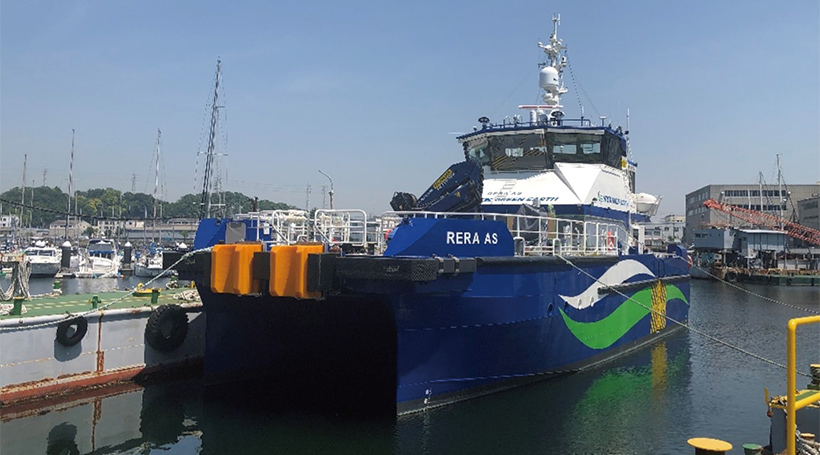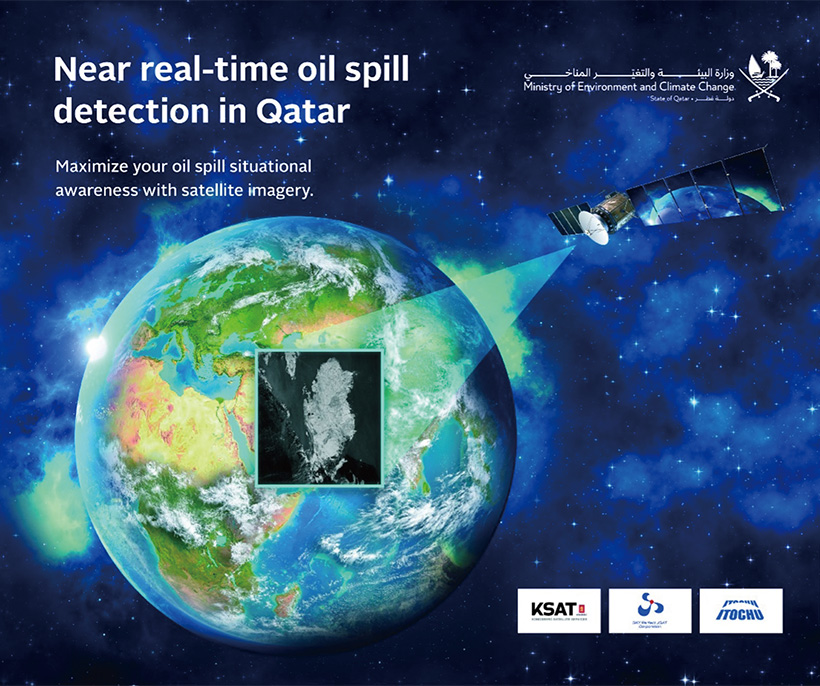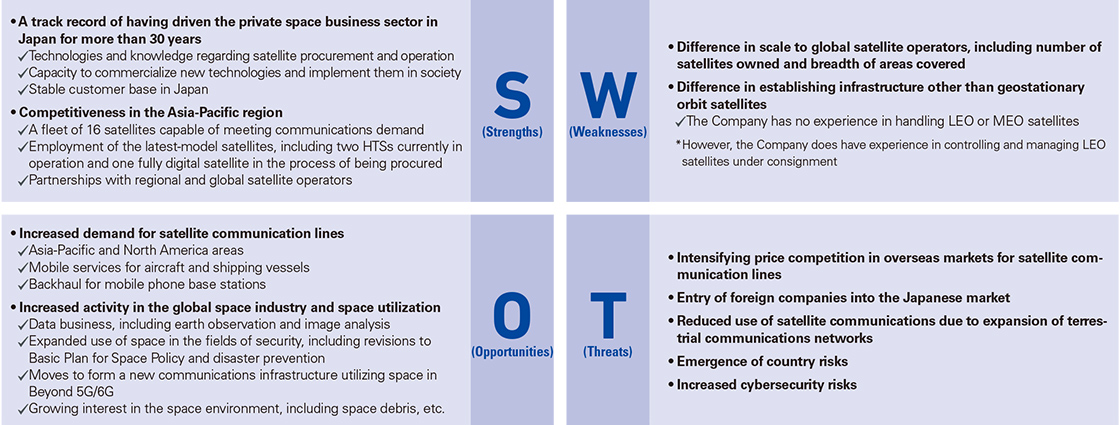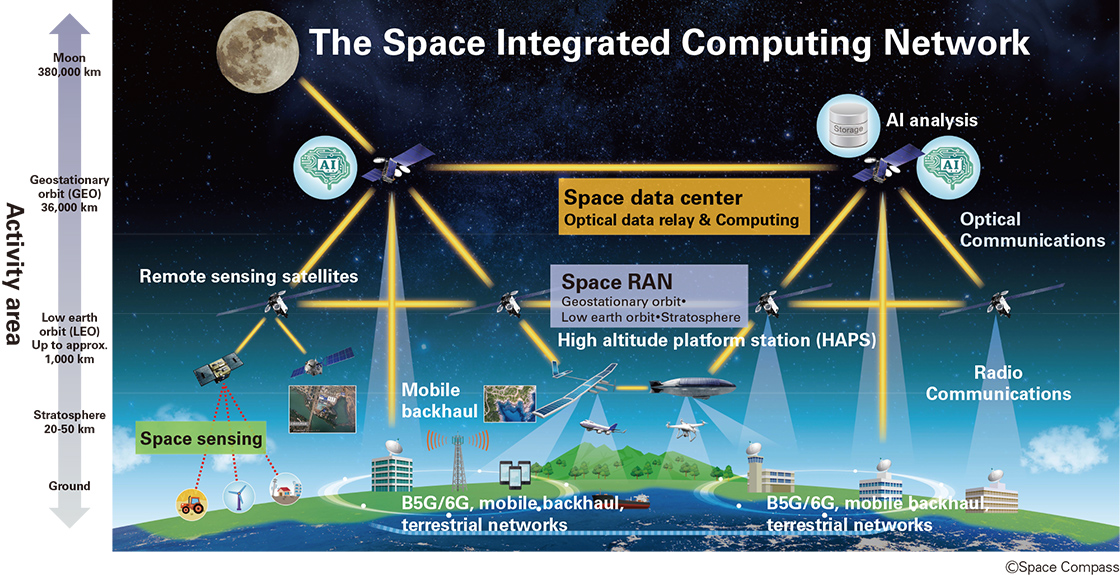SWOT
Medium- to Long-Term Business Strategy
In our Domestic Satellites Business, in March 2023, we concluded an agreement with the Japan Aerospace Exploration Agency (JAXA) to provide a near-earth tracking network* service. In addition to proposing renewals of long-term contracts for communication lines services to existing customers, we also intend to create new revenue opportunities by developing new services that draw on our knowledge in operating communications satellites and lines.
In our Global and Mobile Business, we are aiming to expand use of our two HTSs, JCSAT-1C, and Horizons 3e. In addition, through Horizons 4—the satellite we jointly own with INTELSAT (USA) —which launched in August 2023, we will cater to rising demand for communications in North America and the Pacific region.
In the first half of 2027, we are also planning to commence operations of Superbird-9, a fully digital satellite capable of flexibly adjusting its coverage area and transmissions capacity while in orbit. By meeting the diverse needs of our customers and markets, we will further expand our business and strengthen our competitiveness in Japan and the wider East-Asia region.
In our New Domains Business, we are accelerating the expansion of our services in the field of business intelligence. In November 2022, in partnership with Zenrin Co., Ltd. and Nippon Koei, we established LIANA, a service that uses satellite data to monitor slope change risks and infrastructure risks. In addition, we participated in an additional round of fund-raising held by iQPS Inc., which seeks to provide a quasi-real-time ground measurement data service through a constellation of 36 small-scale synthetic aperture radar satellites (SARs). In July 2023, we concluded a contract to operate these small-scale SARs, thereby strengthening the relationship with this company.
In the field of communications, we are aiming to establish new space infrastructure in partnership with Space Compass and other related companies. In addition to considering the commercialization of services that utilize new technologies, such as satellite quantum key distribution and space debris countermeasures, we intend to actively propose Space Situational Awareness and other services in the field of security.
In our Space Business, our vision is to contribute to the realization of a supersmart society. We are planning to invest ¥150 billion in various fields—including Universal Non-Terrestrial Networks, optical data relays, and business intelligence—in order to establish innovative communications networks and global data collection networks, and our goal is to generate segment profit of ¥21.0 billion by 2030.
- A “near-earth tracking network” is the collective name for the clusters of ground antennae established in Japan and overseas to facilitate communications between in-orbit artificial satellites and the earth, and for the systems used to manage these antennae clusters and their ancillary facilities.
Key Issues and KPIs in the Space Business
| Key issue themes |
Key issues |
Long term | Short term | KPIs/Results | |
| Long-term goals (ideal state for 2030) | Short-term goals to achieve | Fiscal 2022 Results | |||
| Building resilient broadcasting and communications infrastructure, eliminating information gaps | Provision of broadcasting and communications infrastructure to any areas and in any environment | Give connectivity to everything on the planet seeking connection, and constantly provide reliable services, at any time | By developing disaster-resistant broadcasting and communication infrastructure and expanding our reach, we will provide connectivity to all “people who seek connection” on the planet at any time and, anywhere | Expand the usage bandwidth of our satellite fleet from the previous fiscal year | Expanded the bandwidth used by our satellite fleet: Expanded it 113% compared to FY2021 |
|---|---|---|---|---|---|
| Support of BCP and relief recovery through provision of disaster-resilient broadcasting and communications infrastructure | Expand the usage bandwidth of our satellite fleet from the previous fiscal year | Expanded the bandwidth used by our satellite fleet: Expanded it 113% compared to FY2021 | |||
| Initiatives to enhance reliability and sustainability of satellite communication services through technological innovation | Improve service reliability by building partnerships to share back-up satellites and control stations among satellite operators | Reduce the number of major service breaks to zero each year |
No serious service interruptions |
||
| Contributing to the environment to make a decarbonized society and recycling-based economy a reality | Support partner companies for reduction of CO2 emissions via Satellite services | Expand its contribution to renewable energy power generation and supply | Expand the amount of renewable energy generated by user companies of a solar power generation output prediction service |
|
|
| Expand the supply of renewable energy project with Challenergy Inc., a company known for wind power generation | |||||
| Improving the environment in space | Initiatives to remove space debris | Establish a space debris removal service as a business | Realize commercialization of space debris removal services | We were commissioned by a partner company to study the feasibility of commercial space debris removal services, and we have made progress in technological developments and mission analysis and design | |
| Promoting innovation which contributes to the environment and society | Development and promotion of remote sensing | Contribute to environmental conservation and social development by evolving businesses that utilize remote sensing | Expand remote sensing projects |
|
|
Case 1 Uninterrupted communication at sea: “JSATMarine Light” installed on NYK Line’s “RERA AS” crew transport vessel for offshore wind farm
Satellites enable communications in areas where terrestrial communications infrastructure is difficult to establish, such as remote islands and mountainous areas. It also provides communications for mobility, such as aircrafts and vessels. Currently, we offer two satellite-based maritime broadband services—OceanBB plus and JSATMarine—which enable high-speed, high-capacity communications at sea.
In August 2022, we launched “JSATMarine Light”, a flatrate satellite internet access service with optimized coverage and service plans for domestic commercial vessels. By combining this service with “Maritime Mobile® A-Pro”, an LTE-based flatrate data communication service provided by NTT World Engineering Marine Corporation, it realizes an uninterrupted communications at sea.
In May 2023, the service was installed on “RERA AS”, a crew transport vessel for offshore wind farm, owned by NYK Line, and is being used for ship-to-shore communications for business operations and crew welfare.
We will continue striving to improve our services to meet the needs of our customers by providing vital infrastructure that supports vessel operations.
-

RERA AS, a crew transport vessel for offshore wind farm
Case 2 Commencement of SAR Satellite-Based Oil Spill Detection Service in Qatar
In June 2023, SKY Perfect JSAT Corporation and ITOCHU Corporation commenced provision of Synthetic Aperture Radar (SAR) satellite-based oil spill detection service to the Qatari Ministry of Environment & Climate Change (Qatari MECC).
This service is provided in joint partnership with Kongsberg Satellite Services, AS (hereinafter “KSAT”), uses SAR satellite imagery downlinked at KSAT and its partners’ ground stations to detect offshore oil leaks. Following such process, analysis is performed in combination with AIS (Automatic Identification System) information transmitted from vessels, and the vessel with the oil leak can be identified.
In addition to continuously providing this service to Qatar, we plan to expand this service to other countries and companies in sea areas where there is similar demand, protecting the marine environment and preventing damage at important facilities such as desalination facilities and power plants in coastal areas from oil leaks.
We will continue to pursue the enhancement of corporate value by contributing to the sustainability of society and the environment, solving social issues through business activities and aiming for sustainable growth.
-

Image of the SAR satellite-based oil spill detection service provided to Qatari MECC
Current location of our space integrated computing network

Shogo Sasao
Team Manager, Corporate Planning & Strategy Team
Planning & Administration Division Space Business Unit
SKY Perfect JSAT Corporation
By creating a new space infrastructure called “space integrated computing network,” we aim to help realize a sustainable society. To promote this concept, we established Space Compass as a joint venture with NTT in July 2022.
To meet the communication requirements of future society, we plan to build a multilayered communication network (Universal NTN) that includes geostationary orbit satellites, low-earth orbit satellites, and HAPS to solve problems from space that cannot be addressed by terrestrial communication networks alone. One such problem is the regional disparity in communication coverage. In Japan, there are still places where data communication is not available, such as mountainous and depopulated areas. While terrestrial base stations have limited geographical reach, Universal NTN enables users to connect to a network anywhere on the planet.
Low-earth orbit satellites are widely used in the field of earth observation, but because they orbit the earth, the timing for transmitting acquired data to the ground is limited and sometimes takes several hours. This is a challenge in times of disaster when situations need to be assessed immediately. Accordingly, we need to take advantage of the characteristics of satellites in each orbit and combine and coordinate them. Space Compass is developing and procuring optical data relay satellites with the aim of launching an optical data relay service in fiscal 2024. This service will use high-speed, high-capacity optical communications to send high-resolution data, collected by low-earth orbit satellites, to geostationary orbit satellites, which are in constant contact with the ground.
Looking further ahead in the next 10 years, we expect the volume of data generated in space to increase dramatically, so it will be difficult to send all data to Earth even with advances in satellite communication technology, including optical communication. For this reason, we believe we should apply edge computing to space using technology that processes data in space and sends only the necessary data to the ground. We are pursuing a worldview in which infrastructure and optimal communication systems connect seamlessly without people being aware of it.
When in an urban center, for example, one would access a nearby ground base station, when in the countryside climbing a mountain one would connect to HAPS, and when on a plane one would access a geostationary orbiting satellite. In the future, data will be analyzed in space and only the necessary data will be sent to Earth.
Leveraging SKY Perfect JSAT’s expertise in the space business, we hope to join forces with numerous partners to develop a new market and form a space integrated computing network in the 2030s.


